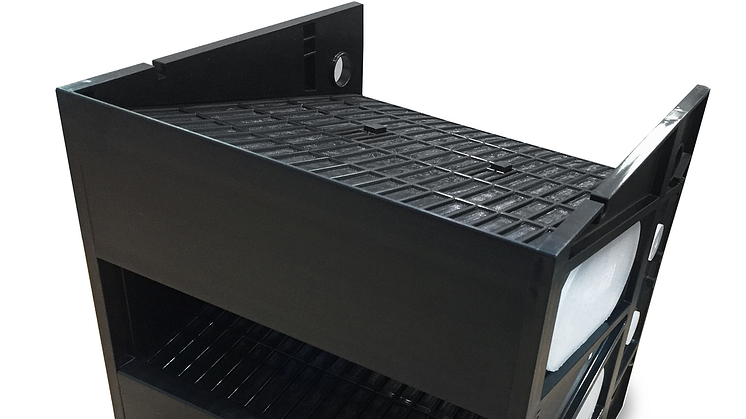
Blog post -
Efficient removal of corrosive, harmful, and odorous contaminants from air with CamCarb VG: engineered molecular filtration solution
CamCarb VG modules with loose-fill media are robust solutions suited for make-up air (outdoor air) and recirculation air systems. The primary use is the control of acidic gases that are responsible for the corrosion of electronics and electrical equipment in heavy process industries such as pulp and paper mills, petrochemical refineries, mining and metal refining operations, and wastewater treatment plants. They are also suitable for lighter applications such as the removal of noxious and odorous fumes generated outside airports, hospital helipads, cultural heritage buildings, and commercial offices located in city centres. The modules can be filled with different types of Camfil molecular filtration media to suit the specific customer application.
There are two standard configurations of CamCarb VG: VG300 and VG440. The VG300 format is best suited for moderate duty (normally make-up air) applications and the VG440 is best suited for light-duty (recirculation air) applications. CamCarb VG filters can be installed in specially designed housings, with options for front-loading, side loading, or positive seal side access (PSSA). They can also be used as replacements in housings and track systems produced by other manufacturers.
CamCarb VG modules are fully welded and constructed without adhesive to eliminate the possibility of off-gassing. They include a unique moulded mesh to allow the use of a full range of loose-fill media without shedding. Many applications will require multiple molecular media to address a range of contaminants. The different media should be deployed in a series of layered modules. This layered approach will provide the highest removal efficiency, the longest life, and the lowest total cost of ownership (TCO) as each media can be changed when it reaches the end of its useful life. Whereas a blended-media requires all the media to be replaced when just a single component has failed.
CAMCARB VG: IMPROVING INDOOR AIR QUALITY BY CONTROLLING CORROSION & ODOUR NUISANCE
Heavy process industries:Many facilities rely on electrical equipment for the safe and efficient operationof complex and valuable manufacturing processes. In certain industries, the external air around the facility is likely to be contaminated with acidic gases. These gases originate from the raw materials used in production or chemicals added to a process.
Oil and Gas (petrochemical): The acidic gases arise from sulphur impurities present in crude oil. Hydrogen sulphide (H2S) occurs naturally in crude oil (sour crudes) and can be generated from refining processes.
Pulp and Paper: The digestion process is the primary generator of hydrogen sulphide, sulphur dioxide, methyl mercaptan, dimethyl sulphide, and dimethyl disulphide. Also, odour causing terpenes are given off by the black liquor. If a mill has a bleach plant, then chlorine and chlorine dioxide will be present in the bleach plant and paper machine areas.
Metal Refining:The primary source of corrosive gases is smelting. Smelting is a process of applying heat to ore to extract a base metal. Sulphur dioxide is produced from the smelting of mineral ores.
Wastewater Treatment:Hydrogen sulphide (H2S) gas typically is formed in wastewater collection systems that are conducive to creating septic conditions. Septic conditions occur when bacteria use all of the available oxygen while the decomposing organic matter in wastewater for energy. Sulphur dioxide (SO2) is a common by-product of this process and can be extremely odorous and corrosive. Chlorine compounds are effective in controlling heavy concentrations of H2S in wastewater collection systems but can have corrosive consequences themselves. All of these contaminants listed above can corrode electronic and electrical control equipment. If protective measures are not implemented the likely consequence will be unscheduled downtime caused by equipment failure. CamCarb VG300 modules can be installed in make-up air units to prevent corrosive gases from entering a space and CamCarb VG440 modules can be installed in recirculation to address contaminants generated indoors.
Airports: The environment surrounding airports is heavily polluted with particulate and gaseous contaminants. Molecular pollution originates from sources such as jet fumes, helipad fumes, which contain hydrocarbons, acetaldehydes, oxides of nitrogen, and ozone. These gaseous pollutants cause a range of health problems from temporary burning eyes to lifelong heart and lung damage. There are also contaminants generated from indoor sources like kitchens, cleaning supplies, construction materials, and travellers. These contaminants can vary, but for the most part, would be considered irritants and odours. Installing CamCarb VG modules in the outdoor air and/or indoor air units will drastically improve indoor air quality (IAQ) in airports.
Cultural Heritage: The primary function of museums, art galleries, archives, and libraries is to preserve artefacts for future generations. Controlling temperature, relative humidity, lighting, particulate pollution (dust), and molecular pollutants (gases) is critical to this preservation. Gaseous pollutants at very low concentrations can cause irreversible damage. Nitrogen dioxide (NO2) and ozone (O3) are common pollutants in city centre environments that are considered corrosive threats to collections. Installing CamCarb VG300 modules in outdoor air units can easily control this threat. Organic acids and formaldehyde are generated indoors from the artefacts themselves. Installing CamCarb VG440 in recirculation air units will control these contaminants generated indoors.
Hospitals: The outdoor air environment around a hospital would have similar molecular contaminants to an airport: hydrocarbons, acetaldehydes, oxides of nitrogen, and ozone. However, the sources of these pollutants would be from helicopter pads and ambulance bays. In some cases, while the concentrations of these contaminants could be low, the hospitals' occupants are much more susceptible due to heart conditions, pre-existing pulmonary issues, and/or age. Protecting patients and employees from these irritant gases is critical. This can be achieved by installing CamCarb VG modules in the outdoor air system and some cases dedicated systems for the helipad. Contaminants can also be generated indoors from sources like kitchens, cleaning supplies, laundry, morgues, burn units, and radio-pharmacy. Installing CamCarb VG modules on recirculation systems can have a continuous impact on the mitigation of these harmful gases.


